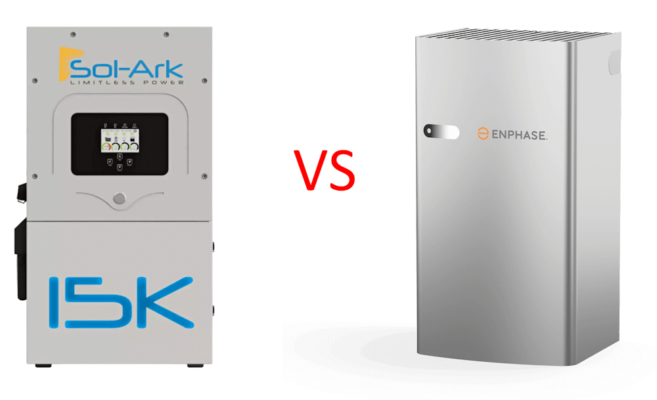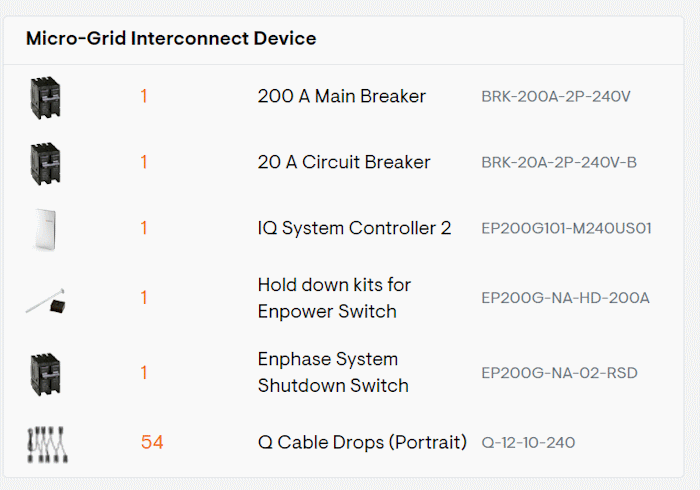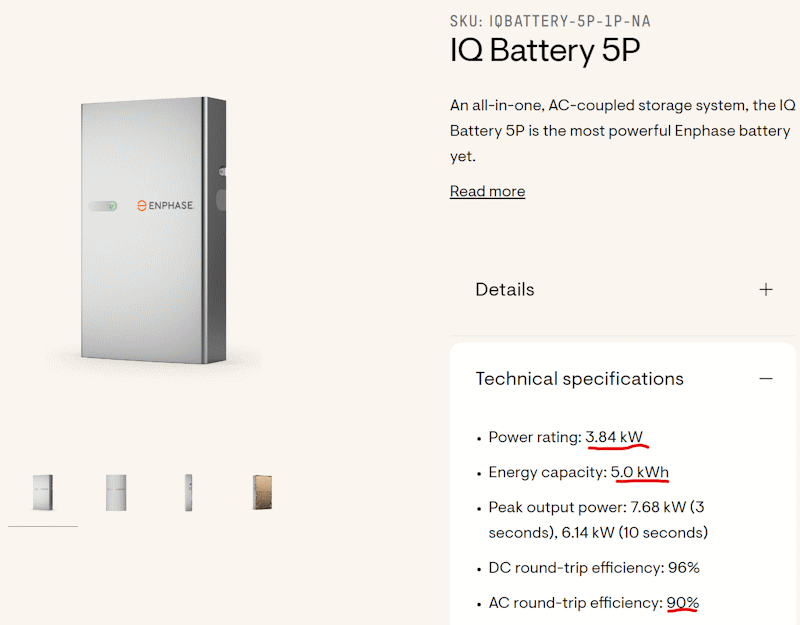Enphase Energy IQ Battery 5P vs Sol-Ark 15K Hybrid Inverter

I’ve received a few questions around the post I wrote comparing some of the popular all-in-one (AIO) inverter batteries to a hybrid inverter plus stand-alone batteries. Most notably from our architect, and the solar/storage company they usually work with. I was planning to write a post digging into that in more detail anyway, so here goes…
I am currently planning to put in two Sol-Ark 15K and four 14.3kWh EG4 PowerPro (57.2kWh) batteries. We will discuss the why in more detail later, saying it now to create context. The solar/storage company is hot for Enphase storage and inverters, specifically the 5P batteries, and I imagine the entire ecosystem because you need that to make the batteries work properly. I don’t know exactly what’s required, but when I walk through their configuration wizard, it plops several items into the mix, including the IQ System Controller 2. So fairly confident it is necessary. We’re going to roll with it as a required component and break down the key areas where I see clear differentiation between the two approaches.

Before getting to that, so it doesn’t go unsaid I don’t believe that Enphase is a bad product. I’m sure it’s fine for many people. This discussion is driven by what I want to accomplish with the passive house. Requirements vary, there is no one size fits all solution. The goal is to explain this complicated topic in more detail, partially because there isn’t a ton of information out there around doing it the way we will be doing it. I was shocked at how one-dimensional most of the discussions around energy storage solutions are. AIO is pushed as the answer; I don’t agree with that. Let’s dig in.
Cost
Enphase
Enphase doesn’t disclose pricing so I have to roll with what I can find around people discussing quotes, and vendors who list their products online. The lack of transparency around price bothers me. I don’t think it’s a blocker, but opaque pricing does not benefit their customers, it benefits the installers.
From what I’ve found online the SRP for the Enphase 5P (IQBATTERY-5P-1P-NA) is ~$5,000, and the street price is ~$3,800. I couldn’t find the SRP for the Enphase System Controller (EP200G101-M240US00), but the street price is ~$1,500. If we use the street prices and do the math to get a baseline hardware cost, we get $47,100 for 60kWh (12 5P + 1 controller).
Those numbers confuse me because when I see quotes. It’s really hard to reconcile that math with the numbers people are sharing. The linked example is $27,300 for a 20kWh (4x5P) install; which puts the total price per 5P on the wall at $6,825. Which if we extrapolate out to 60kWh makes it $81,900. There probably are fixed costs in the mix there, so that it’s unlikely to be $6,825/5P, but it’s what we have to go with. It’s not hard to see why installers like this option.
Sol-Ark 15K + EG4
The 15K SRP is $8,000, street is $7,000. The EG4 PowerPro is $4,249 SRP, $4,000 street. So the total system cost for our 60kWh (actually 57.2kWh) configuration is $30,000. That is not the one-the-wall price. I don’t know how much that would go for, but just hardware is $17,000 less than the 5P. I’ve watched some videos on what’s involved to install 15Ks, and it’s something any licensed electrician should be able to handle. I can’t imagine that it would cost more than $5,000 for them to do it. Obviously that’s just a guess, but we don’t have to have solid numbers there to see the massive difference in price between the two solutions.
Extensibility
Enphase
Because the 5P is an AIO unit, you can’t decouple inverter capability from storage capacity. Each 5P is 3.84kW / 5kWh. That’s it. If you want 20kWh of storage, you have to buy 15.36kW of inverter. The same is true if you flip it. I don’t need 46kW worth of inverter, but if I were to buy the 60kWh setup, that’s what I would get.

There’s also some complexity in the need for orchestration between the battery/inverter units that I don’t know how Enphase works out to keep the batteries balanced. With so much overbuilt inverter, it’s probably not a problem in this case, but there are potential issues with the actual system capability as the batteries discharge with smaller setups.
Sol-Ark 15K + EG4
This is easy because the inverters and batteries are discrete entities. I could roll with one Sol-Ark 15K, it would provide 12kW of inverter capacity from the batteries (15kW if PV is also active). I am planning to provision two Sol-Ark 15K because that 12kW (and I imagine the 3.84kW provided by the 5P) is split-phase 240V – so the maximum 120V output per phase is 6kW. Which given that we’re planning to put in 400A service would mean making a very tightly balanced critical loads panel to reduce the likelihood that more than 6kW of either phase is critical. Adding another 15K doubles the capability, giving us 24kW total and 12kW per phase. If we find that 24kW isn’t enough, for $7,000 plus installation, we can add another 12kW. I won’t need to buy batteries to do that.
The same is true on the battery front. If I want to add more storage, I can get another 14.3kWh for $4,000 plus installation. I could start with only two of the EG4 PowerPro, and decide to add more later. There is an inherent flexibility with this approach that the AIO cannot match.
Supportability
This is a tough one for either solution because I don’t have experience with either, and there isn’t a great way to get a real handle on what it’s like to own and need support for these kinds of products. So this one requires the most guesswork.
Enphase
I suspect that Enphase provides a more general-consumer friendly support experience. There is a dedicated installer, and Enphase also offers direct support if you want to ring them up. That might be a massive feature for some, and it is important. But it also creates some friction because it’s not the kind of setup that any licensed electrician can support. I’m not saying that’s a good/bad thing; it’s just a thing. Mostly a preference thing.
Sol-Ark 15K + EG4
If you buy the network dongle Sol-Ark provides remote support and trouble-shooting. I don’t know how extensive this is. I imagine it’s similar in concept to what Enphase provides. When it comes to the physical units, I don’t know if the installer/dealer also provides support, but I do know that if I wanted to, I could literally buy two of these, have them shipped to my home, and put them on the wall myself. Or, if I wanted to pass an inspection, I could do most of that and then pay any licensed electrician to actually hang it on the wall. The same thing is true for the batteries.
Other Points
Efficiency: Referring back to the 5P spec sheet above. Round-trip efficiency is 90% for the Enphase and 93% for the Sol-Ark 15K.
Response Time: Because the Sol-Ark 15K is directly in the load chain, it can respond to grid events in 5ms. I can’t find that number documented for the 5P. Tesla documents it for their Powerwall, and it’s 30ms.
Space: The Enphase 5P is 98 cm x 55 cm x 18.8 cm (38.6” x 21.7” x 7.4”). If we pretend we can install them right next to each other (you can’t do that) in two horizontal rows, that is 330 cm x 196 cm (130.2” x 77.2”). The EG4 PowerPro are 88 cm x 56.6 cm x 23.2 cm (34.6” x 22.3” 9.1”) and the Sol-Ark 15K are 80.7 cm x 49.4 cm x 30.6 cm (31.8” x 19.4” x 12”). Same basic rules, except now we only need one row, because there are six things to hang on the wall instead of twelve. That number is 322.8cm x 88 cm (128” x 22.3”). And just to be clear, that’s not safe, and that’s not how you do it. It’s just to present some idea of scale. Basically, the Enphase 5P approach will take 2x the amount of space on the wall, however you actually put it on the wall.
Wrapping Up
It should be pretty clear where each solution’s relative strengths lie. If you just want a small backup-only solution to keep the lights on when the grid goes down, or you’re not quite sure how many lights you want to keep on for that short period of time. Enphase might be the right solution because it is an AIO unit that you can add 3.84kW/5kWh at a time. That might make it easier to dip a toe into home energy storage. But, as soon as we start talking about capacities large enough where it becomes easy to leverage the batteries every day; one Sol-Ark 15K and one 14kWh EG4 PowerPro is going to check all the same boxes for cost, extensibility, support, etc. in the same ways that it will with a system like we’re planning to install.

Thanks for the great article. In California with NEM 3, pretty sure that customers will start to be tighter with their money and won’t just throw money at it like before.